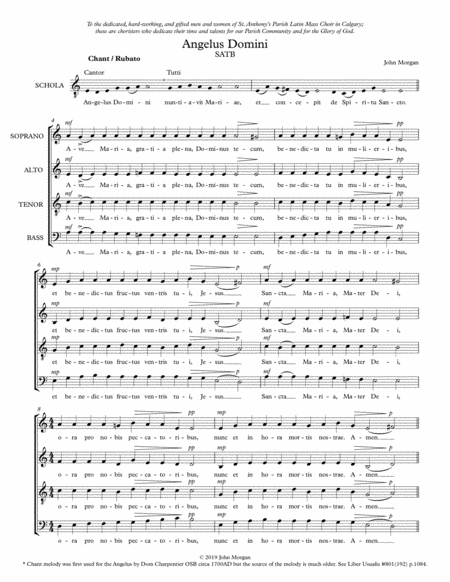Choral Choir (SATB) - Level 3 - Digital Download SKU: A0.939957 Composed by Anonymous. Arranged by John Morgan. Christian,Classical,Contemporary,Sacred. Octavo. 3 pages. Morgan Music #5993589. Published by Morgan Music (A0.939957). An SATB arrangement of Angelus Domini in the style of Maurice Durufle's Ubi Caritas. The ancient and venerable text is retained with it's original Gregorian chant melody.The Angelus is sung 3 times throughout the day with ringing of bells at 9:00 AM, 12 Noon and 6:00 PM. This practice still continues in various parts of the world, in monastic life and in more traditional Catholic communities.This arrangement is also suitable for liturgical use in churchs and schools, particularly for Marian feasts and would also be excellent for Advent or Christmas concert season.English Translation:â„£. The Angel of the LORD declared unto Mary, â„Ÿ. And she conceived of the Holy Ghost. Hail Mary, full of grace; the LORD is with thee: blessed art thou amongst women, and blessed is the Fruit of thy womb, Jesus. Holy Mary, Mother of God, pray for us sinners, now and at the hour of our death. â„£. Behold the handmaid of the LORD. â„Ÿ. Be it done unto me according to thy word. Hail Mary, full of grace; the LORD is with thee: blessed art thou amongst women, and blessed is the Fruit of thy womb, Jesus. Holy Mary, Mother of God, pray for us sinners, now and at the hour of our death. â„£. And the Word was made flesh. â„Ÿ. And dwelt among us. Hail Mary, full of grace; the LORD is with thee: blessed art thou amongst women, and blessed is the fruit of thy womb, Jesus. Holy Mary, Mother of God, pray for us sinners, now and at the hour of our death.â„£. Pray for us, O Holy Mother of God. â„Ÿ. That we may be made worthy of the promises of Christ. Let us pray, Pour forth, we beseech Thee, O LORD, Thy grace into our hearts; that, we, to whom the Incarnation of Christ, Thy Son, was made known by the message of an angel, may by His Passion and Cross be brought to the glory of His Resurrection. Through the same Christ our Lord. â„Ÿ. Amen. â„£ . Glory be to the Father, and to the Son, and to the Holy Ghost. â„Ÿ . As it was in the beginning, is now and ever shall be, world without end. Amen.
